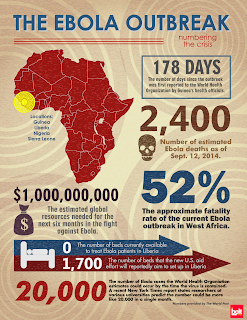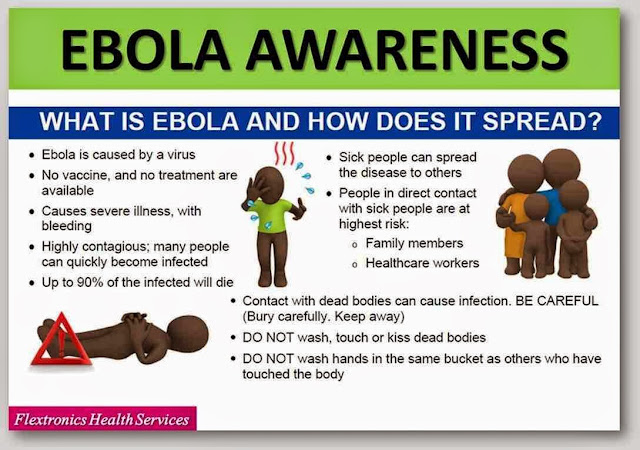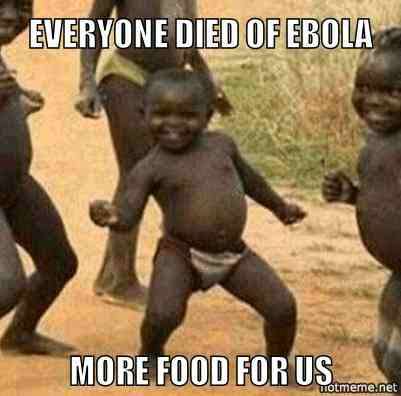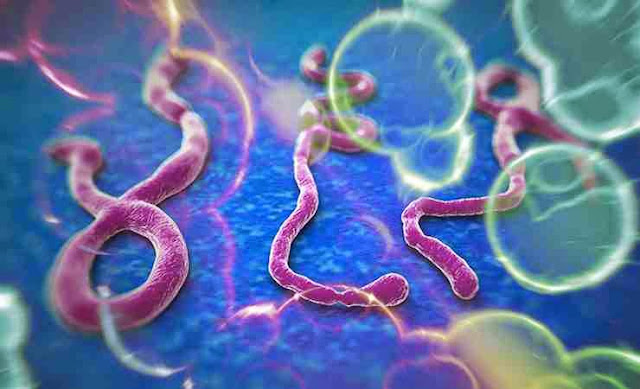ebola virus prevention and treatment
Prevention and control
Good outbreak control relies on applying a package of
interventions, namely case management, surveillance and contact tracing,
a good laboratory service, safe burials and social mobilisation.
Community engagement is key to successfully controlling outbreaks.
Raising awareness of risk factors for Ebola infection and protective
measures that individuals can take is an effective way to reduce human
transmission. Risk reduction messaging should focus on several factors:
- Reducing the risk of wildlife-to-human transmission from contact with infected fruit bats or monkeys/apes and the consumption of their raw meat. Animals should be handled with gloves and other appropriate protective clothing. Animal products (blood and meat) should be thoroughly cooked before consumption.
- Reducing the risk of human-to-human transmission from direct or close contact with people with Ebola symptoms, particularly with their bodily fluids. Gloves and appropriate personal protective equipment should be worn when taking care of ill patients at home. Regular hand washing is required after visiting patients in hospital, as well as after taking care of patients at home.
- Outbreak containment measures including prompt and safe burial of the dead, identifying people who may have been in contact with someone infected with Ebola, monitoring the health of contacts for 21 days, the importance of separating the healthy from the sick to prevent further spread, the importance of good hygiene and maintaining a clean environment.
-


Controlling infection in health-care settings:
Health-care workers should always take standard precautions when caring for patients, regardless of their presumed diagnosis. These include basic hand hygiene, respiratory hygiene, use of personal protective equipment (to block splashes or other contact with infected materials), safe injection practices and safe burial practices.Health-care workers caring for patients with suspected or confirmed Ebola virus should apply extra infection control measures to prevent contact with the patient’s blood and body fluids and contaminated surfaces or materials such as clothing and bedding. When in close contact (within 1 metre) of patients with EBV, health-care workers should wear face protection (a face shield or a medical mask and goggles), a clean, non-sterile long-sleeved gown, and gloves (sterile gloves for some procedures).
Laboratory workers are also at risk. Samples taken from humans and animals for investigation of Ebola infection should be handled by trained staff and processed in suitably equipped laboratories.
Treatment and vaccines
Supportive care-rehydration with oral or intravenous fluids- and
treatment of specific symptoms, improves survival. There is as yet no
proven treatment available for EVD. However, a range of potential
treatments including blood products, immune therapies and drug therapies
are currently being evaluated. No licensed vaccines are available yet,
but 2 potential vaccines are undergoing human safety testing.
Death, if it occurs, follows typically six to sixteen days after symptoms appear and is often due to low blood pressure from fluid loss. Early supportive care to prevent dehydration may reduce the risk of death.
If an infected person survives, recovery may be quick and complete. Prolonged cases are often complicated by the occurrence of long-term problems, such as inflammation of the testicles, joint pains, muscle pains, skin peeling, or hair loss. Eye symptoms, such as light sensitivity, excess tearing, iritis, iridocyclitis, choroiditis, and blindness have also been described.
No specific treatment is currently approved. However, survival is improved by early supportive care with rehydration and symptomatic treatment. Treatment is primarily supportive in nature. These measures may include management of pain, nausea, fever and anxiety, as well as rehydration via the oral or by intravenous route.The World Health Organization recommends avoiding the use of aspirin or ibuprofen for pain due to the bleeding risk associated with use of these medications. Blood products such as packed red blood cells, platelets or fresh frozen plasma may also be used. Other regulators of coagulation have also been tried including heparin in an effort to prevent disseminated intravascular coagulation and clotting factors to decrease bleeding. Antimalarial medications and antibiotics are often used before the diagnosis is confirmed, though there is no evidence to suggest such treatment is in any way helpful. Interferon therapies have been tried as a form of treatment for EVD, but were found to be ineffective.
If professional care is not possible, guidelines by WHO for care at home have been relatively successful. In such situations, recommendations include using towels soaked in bleach solutions when moving infected people or bodies and applying bleach on stains. It is also recommended that the caregivers wash hands with bleach solutions and cover their mouth and nose with a cloth.

Intensive care
Intensive care is often used in the developed world.This may include maintaining blood volume and electrolytes (salts) balance as well as treating any bacterial infections that may develop. Dialysis may be needed for kidney failure, and extracorporeal membrane oxygenation may be used for lung dysfunction.
Alternative medicine
The Food and Drug Administration (FDA) advises people to be careful of advertisements making unverified or fraudulent claims of benefits supposedly gained from various anti-Ebola products. The FDA has already sent out at least one letter of warning to a seller of colloidal silver who made unverified claims of Ebola related benefits, supposedly derived from the use of their products.
Reference
- "Ebola (Ebola Virus Disease) Transmission". CDC. 5 November 2014. Retrieved 7 November 2014.
- Drazen, J.M.; Kanapathipillai R.; Campion E.W.; Rubin E.J.; Hammer S.M.; Morrissey S.; Baden L.R. (2014) "Ebola and Quarantine." N Engl J Med. October 27, 2014 Epub ahead of print PMID25347231
- "Q&A on Transmission, Ebola". CDC. September 2014. Retrieved 3 October 2014.
- Donald G. McNeil Jr. (3 October 2014). "Ask Well: How Does Ebola Spread? How Long Can the Virus Survive?". The New York Times. Retrieved 24 October 2014.
- "How Ebola Is Spread" (PDF). Centers for Disease Control and Prevention (CDC). November 1, 2014.
- "Transmission". CDC. 17 October 2014. Retrieved 18 October 2014.
- Chowell G, Nishiura H (October 2014). "Transmission dynamics and control of Ebola virus disease (EVD): a review". BMC Med 12 (1): 196. doi:10.1186/s12916-014-0196-0. PMC 4207625. PMID 25300956.
- "CDC Telebriefing on Ebola outbreak in West Africa". CDC. 28 July 2014. Retrieved 3 August 2014.
- "Air travel is low-risk for Ebola transmission". WHO. 14 August 2014.
- Chan M (September 2014). "Ebola virus disease in West Africa—no early end to the outbreak". N Engl J Med 371 (13): 1183–5. doi:10.1056/NEJMp1409859. PMID 25140856.
- "Sierra Leone: a traditional healer and a funeral". World Health Organization. Retrieved 6 October 2014.
- Tiaji Salaam-Blyther (26 August 2014). "The 2014 Ebola Outbreak: International and U.S. Responses" (pdf). Retrieved 9 September 2014.
- Lashley, Felissa R.; Durham, Jerry D., eds. (2007). Emerging infectious diseases trends and issues (2nd ed.). New York: Springer. p. 141. ISBN 9780826103505.
- Alan J. Magill, G. Thomas Strickland, James H. Maguire, Edward T Ryan, Tom Solomon, ed. (2013). Hunter's tropical medicine and emerging infectious disease (9th ed.). London, New York: Elsevier. pp. 170–172. OCLC 822525408.
- "Questions and Answers on Ebola | Ebola Hemorrhagic Fever | CDC". CDC.
- "Ebola in Texas: Second Health Care Worker Tests Positive". 15 October 2014.
- Irving WL (August 1995). "Ebola virus transmission". International Journal of Experimental Pathology 76 (4): 225–6. PMC 1997188. PMID 7547434.
- "Risk of Exposure". CDC. 12 October 2014. Retrieved 18 October 2014.
- "FAO warns of fruit bat risk in West African Ebola epidemic". fao.org. 21 July 2014. Retrieved 22 October 2014.
- Williams E. "African monkey meat that could be behind the next HIV". Health News – Health & Families. The Independent. "25 people in Bakaklion, Cameroon killed due to eating of ape"
- "Ebolavirus – Pathogen Safety Data Sheets". Public Health Agency of Canada. Retrieved 22 August 2014.
- Gonzalez JP, Pourrut X, Leroy E (2007). "Wildlife and Emerging Zoonotic Diseases: The Biology, Circumstances and Consequences of Cross-Species Transmission". Current Topics in Microbiology and Immunology. Ebolavirus and other filoviruses 315: 363–387. doi:10.1007/978-3-540-70962-6_15. ISBN 978-3-540-70961-9. PMID 17848072.
- Weingartl HM, Nfon C, Kobinger G (May 2013). "Review of Ebola virus infections in domestic animals". Dev Biol (Basel) 135: 211–8. doi:10.1159/000178495. PMID 23689899.
- Laupland KB, Valiquette L (May 2014). "Ebola virus disease". Can J Infect Dis Med Microbiol 25 (3): 128–9. PMC 4173971. PMID 25285105.




































I was diagnosed as HEPATITIS B carrier in 2013 with fibrosis of the
ReplyDeleteliver already present. I started on antiviral medications which
reduced the viral load initially. After a couple of years the virus
became resistant. I started on HEPATITIS B Herbal treatment from
ULTIMATE LIFE CLINIC (www.ultimatelifeclinic.com) in March, 2020. Their
treatment totally reversed the virus. I did another blood test after
the 6 months long treatment and tested negative to the virus. Amazing
treatment! This treatment is a breakthrough for all HBV carriers.